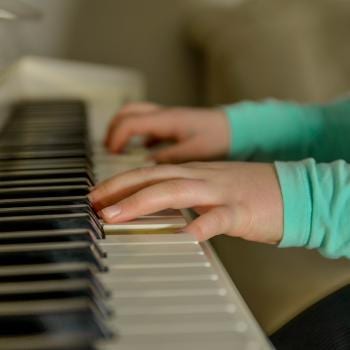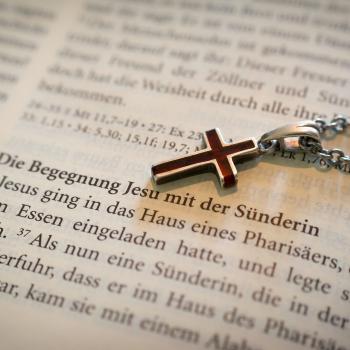Yesterday WORLD Magazine weighed in on Adrian Peterson’s arrest for child abuse.
A grand jury in Texas indicted star Minnesota Vikings running back Adrian Peterson and a warrant for his arrest was issued Friday by the Montgomery County (Texas) Sheriff’s Office for “reckless or negligent injury to a child” for the way he spanked his son.
Notice that last bit—Peterson was arrested “for the way he spanked his son.” Not for abusing his son. Not for leaving his son’s body covered with bleeding lacerations still visible a week later. No. For the way he “spanked” his son.
Peterson’s attorney, Rusty Hardin, said Friday that Peterson cooperated with the investigation and never intended to injure to the boy, who is believed to be 4 years old.
“Adrian is a loving father who used his judgment as a parent to discipline his son,” Hardin said of Peterson’s use what some reports call a “branch,” or “switch,” as Peterson called it, to spank his son. “He used the same kind of discipline with his child that he experienced as a child growing up in east Texas.”
WORLD continues to use the word “spank” to describe what Peterson did, and Peterson’s attorney refers to it as “discipline.” Plenty of othernews outlets have also been referring to what occurred as “spanking” and “discipline.” There is a big problem here both with definitions and with sanitation.
I’ve had people argue that “spanking” is appropriate and and should be allowed, and when asked what they mean they explain that a quick swat with the hand after a child tries to run into the street can help get their attention and communicate the seriousness of their action. Then I’ve described what my parents called “spanking”—being struck with a wooden paddle on my bare bottom until I demonstrated proper penitence for my action—and these same individuals have insisted that that is abuse, not “spanking.” And while my parents consider they way they spanked completely nonabusive, they would have considered what Peterson did to his son abuse (my mother drew blood with a switch only once, and was so horrified that she stopped the session and apologized to the my brother profusely). In other words, what the word “spanking” means—and what considered abuse or simply reasonable discipline—varies from person to person.
The word “spanking” sanitizes the action and papers over the differences in definition. When one person defends “spanking,” they are in a sense unwittingly defending all actions given the label “spanking,” including my parents’ actions and Peterson’s actions. We need to drop this word, or at very least not use it without explaining what is meant. Those who think a quick swat with a hand in the moment should be legal but that what my parents did crossed a line need to make that clear. Similarly, those who think that what my parents did should be legal but that Peterson’s actions crossed the line should likewise make that clear. I would say, “I don’t think hitting a child is ever okay.” Another might say, “I think hitting a child with an open hand in the moment is fine, but I don’t think hitting a child with an object or for long periods of time is okay.” Another might say, “I think hitting a child with a switch or paddle is fine, but I don’t think it should be done in anger or cause bruises or break the skin.” This both adds clarity and removes the sanitizing affect of the word “spanking.”
Personally, I am against hitting a child in any way. I think hitting a child should be against the law. If Peterson had done what he did to his son—whipping him with a switch from a tree until his body was covered with bleeding lacerations—to an adult instead, there would be no question that that was assault. But because hitting children is legal, we have to ask whether or not he “crossed the line”—and his lawyer can argue that what he did falls under reasonable discipline.
Another thing these discussions of Peterson’s charges have demonstrated is a stunning lack of understanding of what child abuse is and what child abusers look like. Most child abusers claim that they are only doing to their children what their parents did to them. Most child abusers insist that they have never intended to injure their children. Most child abusers argue that what they are doing is reasonable discipline. Peterson’s lawyer is using these defenses because he knows the public does not understand child abuse. And yet, the public tends to see child abuse as something only committed by parents who dislike their children and intend to harm them out of malice.
Back to WORLD Magazine for a moment:
In what any other week might have been a fierce debate over when spanking becomes beating, Peterson’s case finds itself squarely in the domestic violence controversy, caught between a public wanting someone to punish and a league desperately trying to protect its image.
Perhaps I should be pleased that WORLD acknowledges that a “spanking” can in some situations become a “beating,” but I’m afraid I’m caught up in WORLD’s suggestion that Peterson is some kind of accidental victim unintentionally caught in the Ray Rice domestic violence “controversy.”
Here is how WORLD described the child’s injuries:
Houston’s CBS Radio affiliate released details from the police investigation, which has been ongoing since the child’s doctor in Minnesota reported the injuries in May. The doctor’s report describes welts and scratches with some scabbing on the child’s back, buttocks, legs, and scrotum. Police said the child also had defensive wounds to his hands.
WORLD left out the word “extensive,” but this description is otherwise accurate.
The child’s punishment was for pushing another child off a motorbike video or arcade game, the report said.
Peterson beat his son as punishment for pushing another child at a video arcade. This is going about things completely backwards. On a simply intuitive level, it should seem obvious that using violence against a child communicates to that child that violence is an acceptable and appropriate part of society (and there are studies that show that this is indeed the case). Using violence to teach a child not to be violent makes no sense.
Beyond that, pushing another child at a video arcade is normal behavior for a 4-year-old. That doesn’t make it acceptable, but it does make it understandable. What would I do in this situation? First, I would take the child aside. I would explain that yes, it can be hard to wait for your turn and that the noise of a video arcade can make it easy to get frustrated, but that pushing other children is not an acceptable way to express that frustration. I would ask how would they feel if some other child pushed them. I would explain more appropriate ways to deal with their frustration—asking an adult for help if the problem if the issue is sharing, or walking away to do something else if waiting their turn becomes so frustrating they have the urge to push or otherwise lash out. This conversation wouldn’t be one-sided—I would start by asking the child why they pushed the other child, and I would ask the child to help think of solutions to their frustration. My goal would be to hold a conversation rather than giving a lecture. We would model and practice, if needed. Then I would let the child go back to playing. If inappropriate behavior occurred again, we would leave the video arcade, and that would be part of the lesson—we remove ourselves from situations where we can’t trust ourselves to act appropriately. And yes, it’s easy to say all this when I’m not in the situation, but I’ve gone through this process many times, and it works—and leads to more actual learning than does pulling a child aside and hitting them.
If you read Peterson’s description of what he did—he claims he continued beating his son for as long as he did because the child didn’t cry (here’s a link, but I’ll warn you that the article contains pictures)—you’ll notice that it fits with what Michael and Debi Pearl teach in their book, To Train Up a Child. I suspect that the Pearls’ teaching that you have to hit the child until they are submissive to your authority is probably more common than we would like to think. And this case demonstrates, once again, where it can lead. Many parents who follow the Pearls, my own parents included, would probably see what Peterson did as crossing a line, and that’s why this needs saying—when you teach that you have to keep hitting until the child shows some sign of submission (crying, in this case), this is what you will end up with. Sure, most kids may show submission long before they are covered in bleeding lacerations, but some will hold out, and it will go on, and on, and on. This is what happens when you see parenting as a battle in which one side must “win” and the other side of necessity must “lose.”
I would contend that there is no situation where hitting a child is more productive or healthy than other means of correction. I also don’t think any human child deserves to be hit. I mean for goodness sake, we no longer give criminals 40 lashes and we don’t sentence convicts to being beaten. How is it that we have given these up as inappropriate and yet we still feel it is somehow instructive or good to hit children? We as a society need to stop giving cover to child abuse by arguing that parents should be allowed to hit their children and using sanitizing words like “spanking” without definition—and we need to correct our assumptions about what an abuser looks like (and doesn’t look like). We need to promote healthier childrearing practices and consign hitting children—no matter what we call it—to the dustheap of history.














